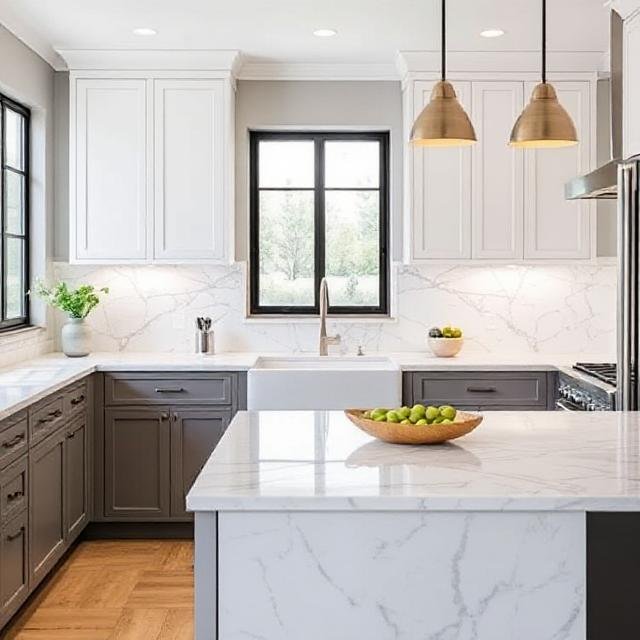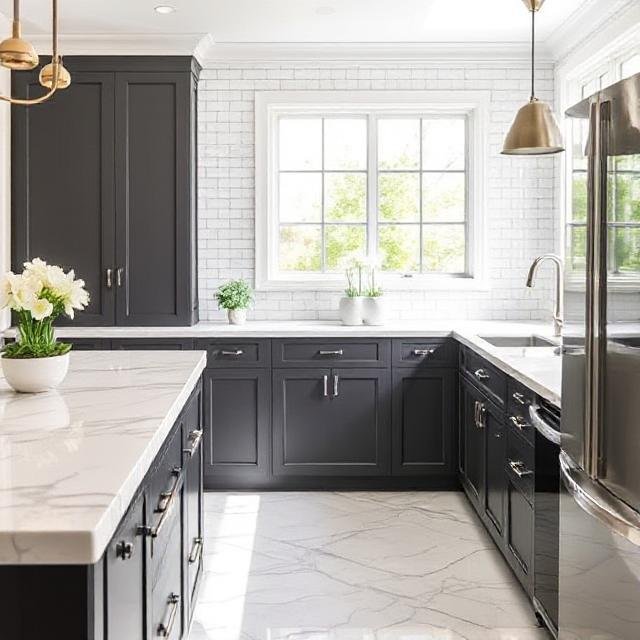Choosing a perfect white marble for an Indian kitchen countertop is the best decision, as it balances the durability, heavy-duty work, aesthetics, and matching the lifestyle. The Calacatta and Carrara Italian marble are quarried from the Apuan Alps region. They both have white backgrounds with gray veins; their subtle differences in the availability, appearance, and cost can significantly influence the final choice of buyer.

Here is a detailed breakdown for both Carrara and Calacatta marbles, which helps to decide the best fit for your kitchen countertop.
The Marble Showdown: Carrara vs. Calacatta
The core difference between these two stones comes down to their visual profile and rarity.
| Feature | Carrara Marble | Calacatta Marble |
| Background Color | Soft, light gray-white | Crisp, brilliant white |
| Veining | Soft, feathered, linear, and subtle | Thick, bold, dramatic, and sporadic |
| Vein Color | Light gray, often with a blue-gray tone | Dark gray, gold, or beige, offering high contrast |
| Aesthetic | Classic, understated, and elegant | Luxurious, dramatic, and a true focal point |
| Rarity | More abundant and widely available | Rarer, extracted in smaller, more limited quantities |
| Cost | Generally more affordable (entry-level luxury) | Significantly more expensive (premium luxury) |

Carrara: The Understated Classic
Carrara marble is the most commonly used Italian marble globally. It has a soft, muted look and is a versatile choice that easily blends with various kitchen styles from traditional to modern minimalist.
- Subtle Elegance: Carrara marble has feathery thin veins that create a harmonious appearance. The low contrast between the gray base and gray veins means the countertop provides an elegant background.
- Budget-Friendly Luxury: Due to its greater abundance, Carrara is cost-effective for achieving an Italian marble kitchen with sophisticated appeal. It is budget-friendly luxury.
- Practicality: The softer gray background veins are often better at hiding minor etching and small stains that are inevitable in a busy kitchen.
Calacatta: The Statement Showstopper
Calacatta marble is prized for its rarity and beautiful veins. It is the choice for homeowners who want their countertop to be a genuine work of art.
- Dramatic Flair: Calacatta has a unique feature with a bright white base, against which its thick, dramatic veins stand out.
- High-End Appeal: Its scarcity and vibrant white color are associated with ultimate luxury and exclusivity, making it a significant investment. Interior designers often use Calacatta for bookmatched feature walls or large kitchen islands.
- Visibility: The marble has a bright white color; hence, the stains and etching are more noticeable on the surface of the marble.
Durability and Maintenance: A Tie
In terms of functionality, there is no virtual difference between both Carrara and Calacatta marble. Both are composed of calcium carbonate.
- Porous: Marble is porous in nature, and it can easily absorb liquids like coffee, oil, and water if it is not sealed regularly.
- Acid-Sensitive: Both will etch when they are exposed to acidic substances like vinegar, tomato sauce, and lemon juice. When acidic liquid contacts the surface, a chemical reaction happens, and the marble starts etching.
Regardless of your choice, both the marble require regular sealing every six months and proper cleanup of spills.

Conclusion: Which is Best for You?
The “best” marble for your kitchen is the one that aligns with your design vision, budget, and maintenance tolerance.
- Choose Carrara if:
- You prefer a soft, classic, and understated look.
- You are working with a more moderate luxury budget.
- You want a stone that is slightly more forgiving with minor wear and tear due to its subtle gray undertones.
- Choose Calacatta if:
- You desire a bold, dramatic, and high-contrast focal point.
- Your budget is premium and you view the countertop as an investment piece.
- You are prepared for the higher visibility of stains/etching and committed to rigorous upkeep.
Both Carrara and Calacatta are timeless choices that promise to elevate your kitchen’s aesthetic. Your marble countertop will develop a beautiful patina over time, a characteristic that marble lovers often embrace as part of the stone’s story.
FAQs
1. Is Calacatta or Carrara more durable?
They are equally durable. Both are authentic marbles and require similar maintenance, including regular sealing to protect against stains and quick cleanup to prevent etching from acids.
2. Can I use marble in a high-traffic kitchen?
Yes, but you must be prepared for the maintenance. Marble is a relatively soft, porous stone that will etch and can stain. For a true low-maintenance option, consider marble-look quartz, which mimics the look without the care requirements.
3. Does a honed or polished finish hide etching better?
A honed finish (matte) is generally better at disguising minor scratches and acid etching because it doesn’t have the high gloss of a polished surface to dull.
4. What is Statuario marble?
Statuario is another famous Italian white marble. It’s often compared to Calacatta as it has a brilliant white background but typically features even bolder, more defined veining, making it even rarer and more expensive than Calacatta.


